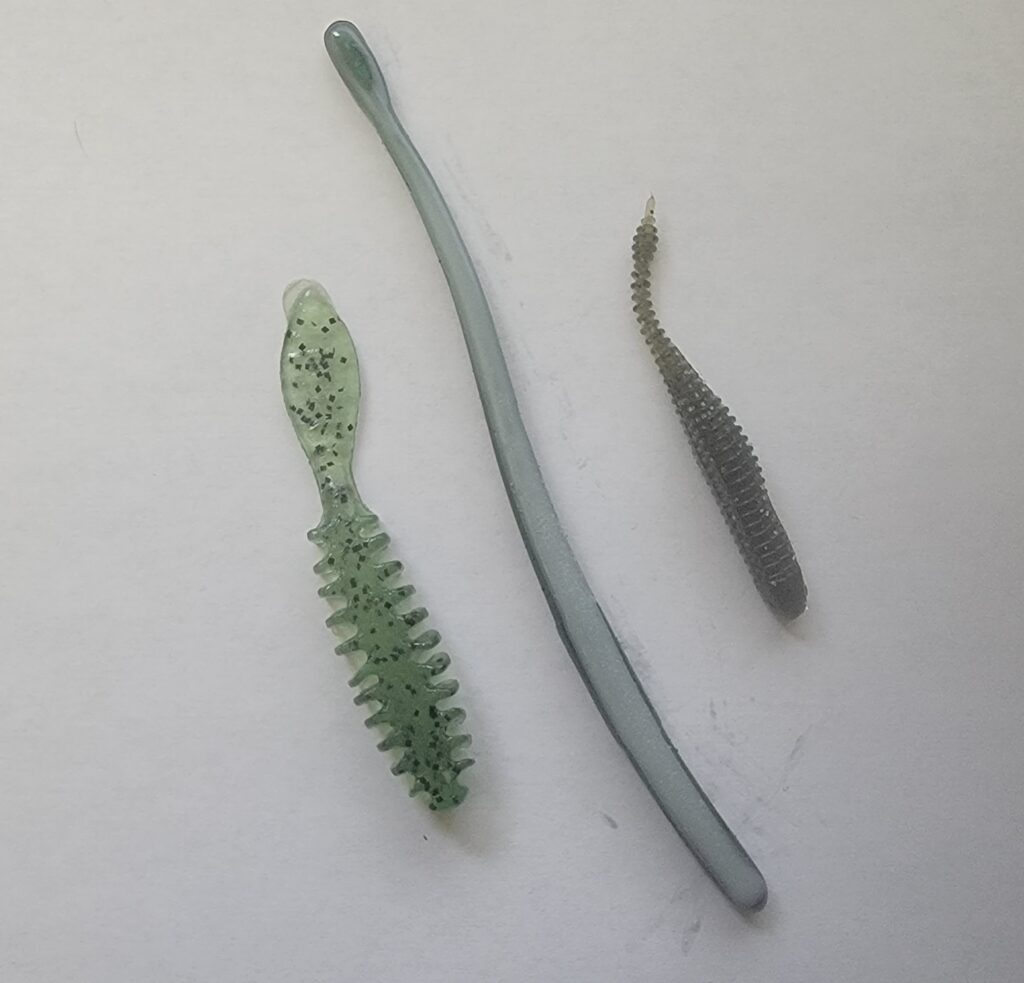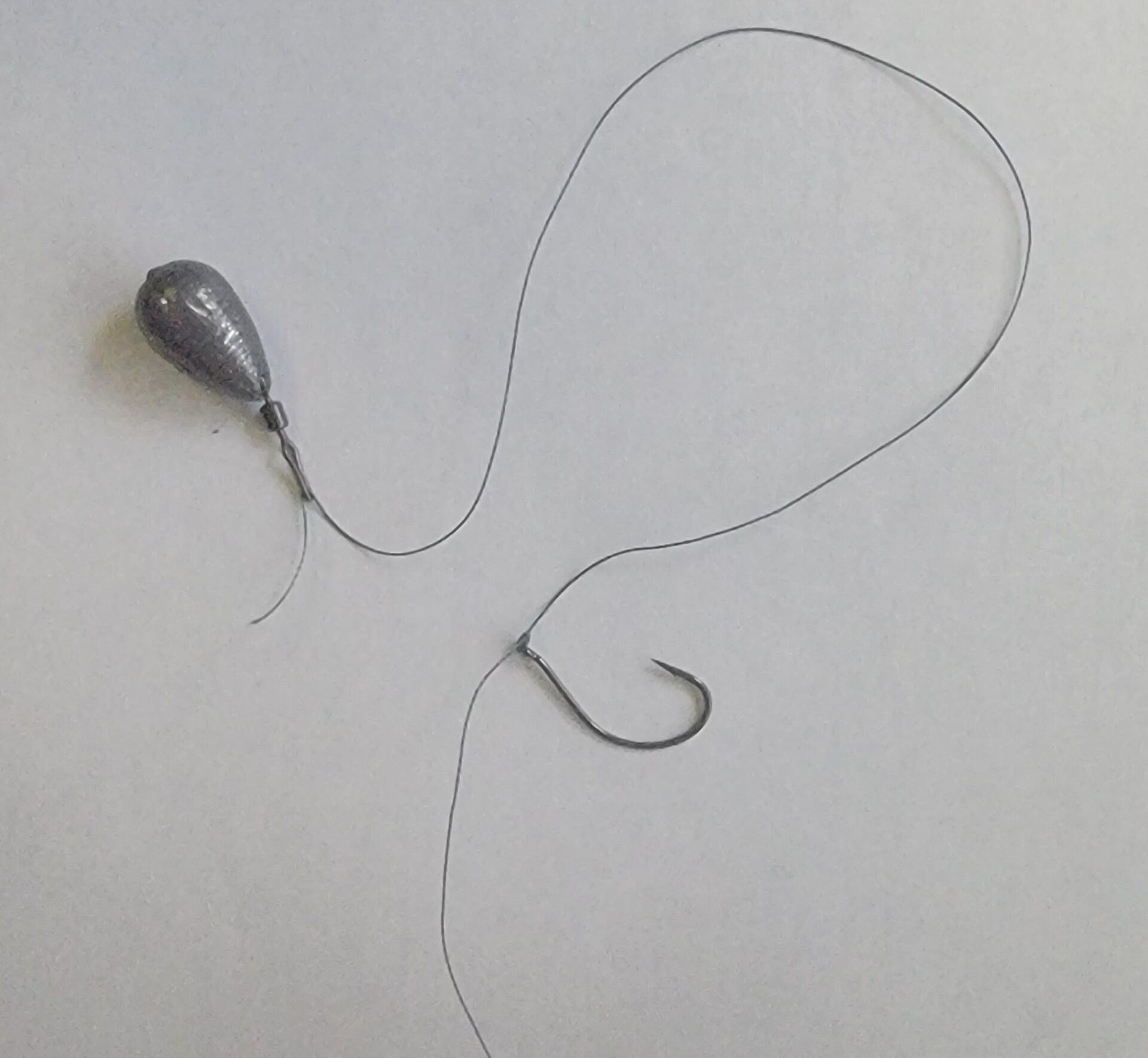If you like to fish for bass, using a drop shot rig is a great way to catch them. Rigging a drop shot varies depending on conditions and location. In this article, we teach you drop shot rigging in a way that will work everywhere!
1. Bass Drop Shot Setup
A proper bass drop shot setup starts with the right gear. From rods and reels to lines and weights, each component plays a crucial role in delivering a realistic bait presentation and detecting subtle bites. Some bass drop shot setups will have to be altered for the size of fish you are catching. For example, Lake Erie bass fishing may require a larger setup than inland lakes.
Essential Gear for a Drop Shot Setup
- Rod: Medium-light to medium spinning rods with a fast action tip are ideal. Lengths between 6’6” to 7’6” allow for better control and sensitivity.
- Reel: Pair the rod with a 2000–3000 size spinning reel for smooth drag and lightweight performance.
- Line:
- Mainline: 6–10 lb fluorocarbon for stealth and sensitivity.
- Braided Line with Fluorocarbon Leader: Offers durability and improved casting distance.
- Weights:
- Round Weights: Best for sandy or muddy bottoms.
- Cylinder Weights: Perfect for rocky or weedy areas as they resist snagging.
- Weight Sizes: Typically 1/8 oz to 1/2 oz depending on depth and current.
- Hooks: Use drop shot hooks (size 1 to 1/0) for optimal bait presentation.
| Component | Recommendation |
|---|---|
| Rod – BUY HERE | 6’6”–7’6” Medium-Light Spinning |
| Reel – BUY HERE | 2000–3000 Size Spinning Reel |
| Line – BUY HERE | 6–10 lb Fluorocarbon or Braid |
| Weights – BUY HERE | 1/8 oz – 1/2 oz Round or Cylinder |
| Hooks – BUY HERE | Size 1–1/0 Drop Shot Hooks |
Selecting Drop Shot Baits

Choosing the right bait can make or break your fishing day.
- Soft Plastics:
- Worms: 4–6 inches, perfect for mimicking natural prey.
- Minnows: Great for imitating small baitfish.
- Creatures: Ideal for targeting aggressive bass.
- Colors:
- Natural Colors: Green pumpkin, watermelon, and shad for clear water.
- Bright Colors: Chartreuse and pink for stained or murky water.
Pro Tip: “Match the hatch.” Observe local baitfish and select colors and shapes that closely resemble them.
Customizing Your Setup for Different Conditions
- Deep Water: Use longer leaders (12–24 inches) and heavier weights.
- Shallow Water: Shorter leaders (6–12 inches) and lighter weights maintain finesse.
- Current or Wind: Increase weight size to keep the rig stable and near the bottom.
2. Tying a Drop Shot Rig
Tying the perfect drop shot rig is easier than you might think, but attention to detail ensures success.
Step-by-Step Instructions
- Tie the Palomar Knot:
- Double the line and insert it through the hook eye.
- Tie a loose overhand knot, keeping the hook inside the loop.
- Pull the loop over the hook and tighten securely.
- Leave a Tag End:
- Ensure at least 12–24 inches of line below the hook for the weight.
- Attach the Weight:
- Slide the tag end through the weight’s clip or tie a simple knot.
- Position the Hook:
- Make sure the hook points upward for a natural bait presentation.
Tips for Beginners
- Always moisten knots before tightening to prevent friction damage.
- Keep leader lengths adjustable based on water depth and fish activity.
- Use a swivel if line twisting becomes a problem.
Advanced Techniques
- Tandem Drop Shot Rigging: Use two hooks at different depths to target multiple zones.
- Weedless Setup: Thread the hook through the bait for fishing heavy cover without snagging.
- Flipping Drop Shot: Shorten the leader and pitch into tight spaces like docks or brush piles.
3. Casting a Drop Shot Rig
Casting a drop shot rig correctly ensures it reaches the right spots while maintaining control.
Best Casting Techniques
- Underhand Pitching: Ideal for short, precise casts near cover.
- Sidearm Casting: Works well in windy conditions or when skipping under structures.
- Long-Distance Casting: Use longer rods for better reach and control.
Drop Shot Rig Placement
- Rocky Areas: Bass often hide around rocks for cover and ambush points.
- Weed Beds: Fish near edges to avoid snags while attracting bass.
- Drop-offs and Ledges: Excellent locations for targeting suspended fish.
Challenges and Solutions
- Wind and Current: Increase weight size for stability.
- Line Twisting: Use swivels to minimize tangles.
- Detecting Bites: Keep a tight line and feel for subtle tugs.
4. Bass Fishing Drop Shot Technique
The right drop shot technique can turn a good day into a great one.
How to Present the Bait
- Shaking: Light rod movements create subtle vibrations that mimic live bait.
- Dragging: Slowly pull the rig along the bottom to cover more ground.
- Deadsticking: Let the bait sit still to entice inactive fish.
Reading the Water and Adapting Techniques
- Clear Water: Use lighter lines and natural bait colors.
- Murky Water: Opt for brighter colors and larger baits for visibility.
- Seasons:
- Spring: Fish near spawning beds.
- Summer: Focus on deep ledges and drop-offs.
- Fall: Target weed edges where bass feed aggressively.
- Winter: Use slower presentations in deeper water.
Common Drop Shot Mistakes to Avoid
- Overworking the Bait: Too much movement can look unnatural.
- Wrong Weight Size: Adjust weights based on depth and conditions.
- Poor Knot Tying: Weak knots can lead to lost fish.
Tips for Success
- Experiment Often: Change bait styles and colors if bites slow down.
- Stay Patient: Finesse fishing requires slower movements and attention to detail.
- Keep a Logbook: Record conditions and results to track patterns.
Hopefully, this guide will help you have more success on the water. Fishing a drop shot takes some time to master. By practicing, we are sure you will catch fish!

